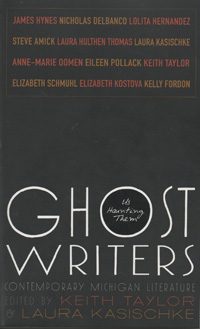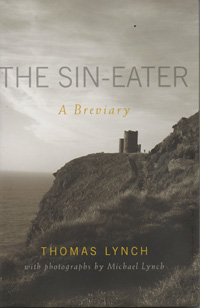Column: Book Fare
The upcoming trifecta of other-worldly holidays – Halloween, All Saints’ Day, All Souls’ Day – are the perfect frame to showcase a pair of new literary treats from local authors. (A neat trick, no?)
“The Sin-Eater: A Breviary,” Thomas Lynch’s latest collection of poems from Paraclete Press, presents this world and the next according to Argyle, an insurance policy incarnate for unabsolved offenses and, Lynch writes, “the mouthpiece for my mixed religious feelings.”
“Ghost Writers: Us Haunting Them,” part of the Made in Michigan Writers Series from Wayne State University Press, serves up a dozen ghost stories – some fiction, some true in their own way – from some of the state’s finest writers, many of them from the Ann Arbor area. Laura Kasischke (“Space, In Chains” and “The Raising”) and Keith Taylor, whose next poetry collection, “Marginalia for a Natural History,” comes out next month, are the editors as well as contributors.
Taylor, who teaches English at the University of Michigan, and “Ghost Writers” contributor Elizabeth Kostova (“The Historian,” “The Swan Thieves”) will read from the collection at Zingerman’s Roadhouse on Wednesday, Oct. 26, at the sixth annual Vampires’ Ball, a benefit for Food Gatherers. (Hunger. In Washtenaw County. In America. Sin? Horror story? This theme is definitely hanging together here.)
Scary Stories
The standout in “Ghost Writers” is “Not Even Lions and Tigers,” Steve Amick’s wryly funny tale of enforcer Harry Bennett driven mad by the “haints” of strikers and organizers he bloodied in the service of Henry Ford (though, he’d insist to his disappointed ma, “he was in his office for most of it”). As he exhibited so well in his novel “Nothing But a Smile,” Amick is just great at nailing place and period with the energizing element of utterly authentic speech. His Bennett flings off sentences studded with gems like “whorebath,” “hoohaw” and “cooked up the wheeze” (translation: authored the joke). Plus, we get some local history: Harry Bennett, born on Ann Arbor’s Wall Street; stepson of an early member of UM’s engineering faculty; a frustrated artist who raised Wyandotte chickens on his Geddesburg estate. Now you know.
With “Ghost Anecdote,” Kasischke again gives us a story of a bad-ish girl, a dead mom and suburban vice and again leaves us marveling at her lethal skill with the lightning-bolt detail (and, again, imagining she would have been a blast to cut class with in high school). Nicholas Delbanco’s “Pier Road” offers a meditation on what vanishes from a place and what remains: “What are we haunted by, and why?”
Anne-Marie Oomen’s “Bitchathane” introduces us to “spider ghosts,” via the red-haired narrator’s Aunt Toots and in the Upper Peninsula, where women in steel-toed boots do construction work alongside their husbands, have their hearts broken and, sometimes, pieced back together in a tight package of revenge. And this captivating story introduces me to Oomen’s wonderful voice, and will lead me to check out her latest collection of essays, “An American Map” (from Wayne State University Press, 2010).
Scary stuff aside, it’s fun just to do some Michigan sightseeing in the pages of “Ghost Writers.” Greenfield Village. Harbor Springs. At the Detroit Institute of Arts, the up-north high school teacher in Taylor’s “The Man at the Edge” encounters Diego Rivera’s Detroit Industry panels – they “all looked as if they pictured disembodied organs of the female reproductive system.” And it’s the place – Michigan – as much as the theme of haunting, of a present given deeper meaning by an undead past – that makes this collection worth the read.
“The ghosts in Michigan, perhaps like ghosts everywhere, seem to stay close to home,” the editors observe in the preface. And to this Taylor’s daughter, Faith, gets off a good one: “‘Well, good for the ghosts! At least they still call it home.’”
The Sacred and Profane
The next generation adds a special dimension as well to “The Sin-Eater.” To accompany “a couple dozen poems, a couple dozen lines each,” are a couple dozen truly fine photographs taken in Ireland by Michael Lynch, the poet’s son. (Another son, Sean, contributes a watercolor.)
Both Milford, Michigan, and Moveen in County Clare are home to Lynch, in whose magnificent “Walking Papers” Argyle made his first appearance. As with “Ghost Writers,” place and the dicey transition to an afterlife are central themes in “The Sin-Eater.” It is medieval (in sensibility if not in time) Ireland, where for a loaf of bread, a bowl of beer and six pence Argyle will squat beside a laid-out corpse, “eating sins and giving souls their blessed rest.” Like any working stiff, there are gigs he prefers more than others:
Maybe steady work with nuns whose vices
were rumored to go down like tapioca.
But no, those clever ladies lived forever
and for all their charities would starve the man
who counted for his feed on their transgressions.
No, most of Argyle’s work comes from rank-and-file sinners, whose resentful mourners may suspect a racket but will cover all the bases nevertheless. And he catches it from both sides. In “Argyle in Carrigaholt,” the “grinning” sin-eater gets chewed out by a prelate “famous for / the loud abhorrence that he preached against / adherence to the ancient superstitions.” But Argyle harbors his own contempt for those “who do a brisk trade in indulgences / and tithes and votive lamps and requiems.”
Cruelty toward the defenseless turns his stomach, and more than once he finds himself in profound solidarity with wronged innocents who succumb to the deadly sin of despair and are denied “requiem or rosary.” This refusal of official mercy is at the heart of two of the collection’s most powerful poems: “Argyle’s Ejaculations” and “He Posits Certain Mysteries.”
The father’s words and the sons’ images create a haunting whole. “The Sin-Eater” is a beautiful work of art.
About the writer: Domenica Trevor lives in Ann Arbor and can be scary when she sets her mind to it. Her columns are published periodically in The Ann Arbor Chronicle. The Chronicle relies in part on regular voluntary subscriptions to support our columnists and other contributors. If you’re already supporting The Chronicle, please encourage your friends, neighbors and coworkers to do the same. Click this link for details: Subscribe to The Chronicle.





